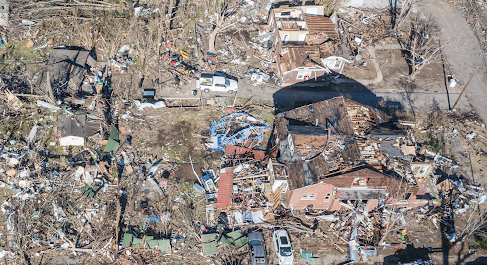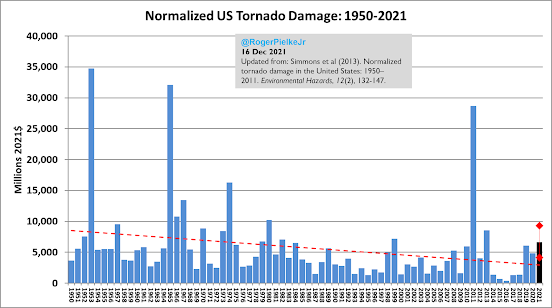Were the Recent Tornadoes the Result of Global Warming?

As I will demonstrate below, these claims are contradictory to the best science and at odds with respected international and national scientific assessments. Many are based on simplistic arguments that demonstrate a lack of understanding of the ingredients required for severe convection (thunderstorms) or evince a lack of knowledge of the historical record.
Have Strong Tornadoes Been Increasing in the U.S.?
The very first question one must ask when evaluating the role of global warming (or "climate change" as some folks prefer), is whether there is a trend. If global warming is contributing to severe tornado frequency or strength, one would expect an extended trend over decades.
Below you will see a plot of the frequency of strong tornadoes (EF 3, 4, 5) over time for the U.S. (and keep in mind that such strong tornadoes are pretty much limited to the Plains states and the SE U.S.) from the NOAA/NWS Storm Prediction Center. The trend is DOWNWARD towards fewer strong tornadoes. So if there is a trend to a "new normal" it is for LESS strong tornadoes.
Normalized tornado damage (which considers changes in changes in the cost of living and growth) is similar. No upward trend, downward if anything.
Some individuals are displaying the trend of all tornadoes over time, but this is problematic because we are now much more capable of observing the weakest tornadoes, many of which were missed 40 to 80 years ago.
The latest IPCC (Intergovernmental Panel on Climate Change) report states:
- "trends in tornadoes... associated w/ severe convective storms are not robustly detected"
- "attribution of certain classes of extreme weather (eg, tornadoes) is beyond current modeling and theoretical capabilities"
- "how tornadoes... will change is an open question"
"Observed trends and projections of future changes in severe thunderstorms, tornadoes, hail, and strong wind events are uncertain."
Claims Unsupported By Science or Data
- Strong atmospheric instability is essential, with temperature declining rapidly with height.
- A large change in wind with height (wind shear) is critical, both for allowing storms to become intense and to produce the rotation in supercell thunderstorms, the parents of most severe tornadic events.
- And one needs upward motion or lift to release the instability, and this can be from a strong front or an upper-level trough or jet streak.
And there are more requirements I won't go into here.
Simply warming the surface is not enough to enhance severe thunderstorm development.
Good evidence for this is provided by a map showing the climatology of tornadoes around the planet. Tornadoes are infrequent in the warm, humid tropics, where large and frequent thunderstorms are noted. Essential ingredients are missing.
So claims that warming will produce more severe tornadic thunderstorms should be taken with a big grain of salt...severe tornadic thunderstorms depend on an array of requirements, some of which could well weaken under global warming
Finally, let me note that even the local warming claims have issues. For example, we are in a moderate La Nina year, which produces warmer than normal conditions over the southeast U.S. Blaming all of it on global warming is problematic.
The Bottom Line
Claims that the severe tornadoes experienced last Friday evening were the result of global warming/climate change have little basis in the scientific literature or meteorological observations. Observed trends contradict the claims. No such conclusions have been made by the leading scientific groups (e.g., the IPCC).
Unfortunately, it is a potent example of the politicization of weather and climate, which leads to fearful populations and a lack of action on key protective technologies, such as improved construction and better warnings.











Comments
Post a Comment